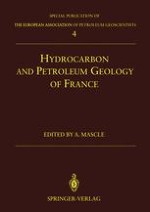1994 | OriginalPaper | Buchkapitel
Subsidence in the Parentis Basin (Aquitaine, France): Implications of the Thermal Evolution
verfasst von : M. F. Brunet
Erschienen in: Hydrocarbon and Petroleum Geology of France
Verlag: Springer Berlin Heidelberg
Enthalten in: Professional Book Archive
Aktivieren Sie unsere intelligente Suche, um passende Fachinhalte oder Patente zu finden.
Wählen Sie Textabschnitte aus um mit Künstlicher Intelligenz passenden Patente zu finden. powered by
Markieren Sie Textabschnitte, um KI-gestützt weitere passende Inhalte zu finden. powered by
Subsidence analysis of the Aquitaine basin, using data of oil wells and seismic lines, allows the determination of some points whose history is representative of the sub-basins’ evolution, with a multiphase rifting from the Paleozoic until the early Cretaceous. The deep crustal structure of the Parentis basin derived from ECORS survey data is interpreted in terms of crustal thinning history and lithospheric thermal evolution. It has been numerically modeled with a homogeneous thinning model, until a good fit with data observed. The modeling gives an estimation of the maximum horizontal extension value along the section (around 40 km), when the crustal volume is preserved. Results of subsidence modeling, with the constraint of the present crustal thickness, show an excess of subsidence of 700 m at present, with regard to observed subsidence. Two processes may add their effects to contribute to the shallow observed subsidence: support of the basin by a nonzero flexural rigidity or a modification of the thermal regime. In this case, the lithosphere should be thinner than that predicted by a normal cooling; it would imply a supplementary thermal event or a process preventing the lithosphere to return to its initial thickness by cooling after the last rifting phase. The thermal modeling evolution is used for an estimation of conditions favorable to oil generation in the middle of the Parentis basin.
